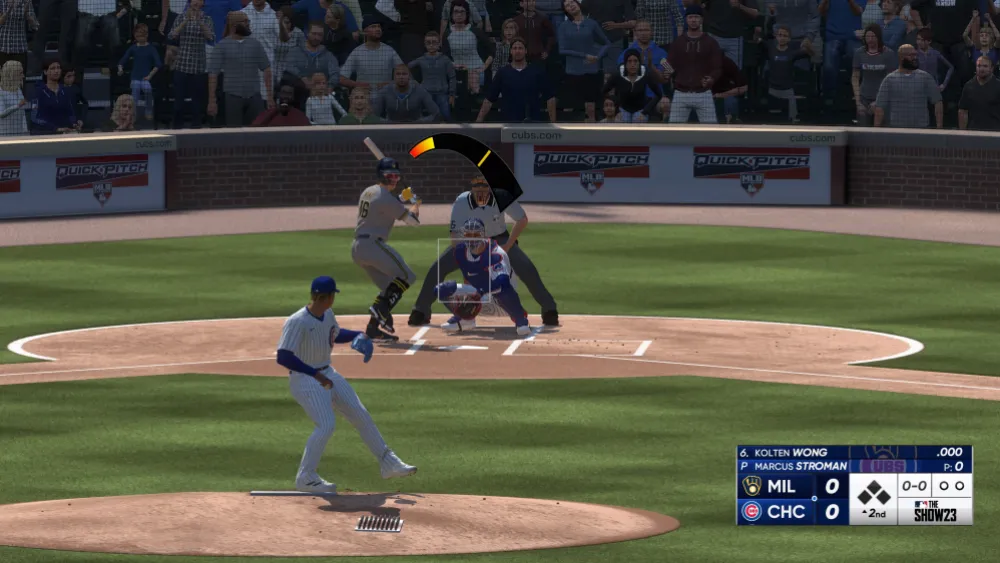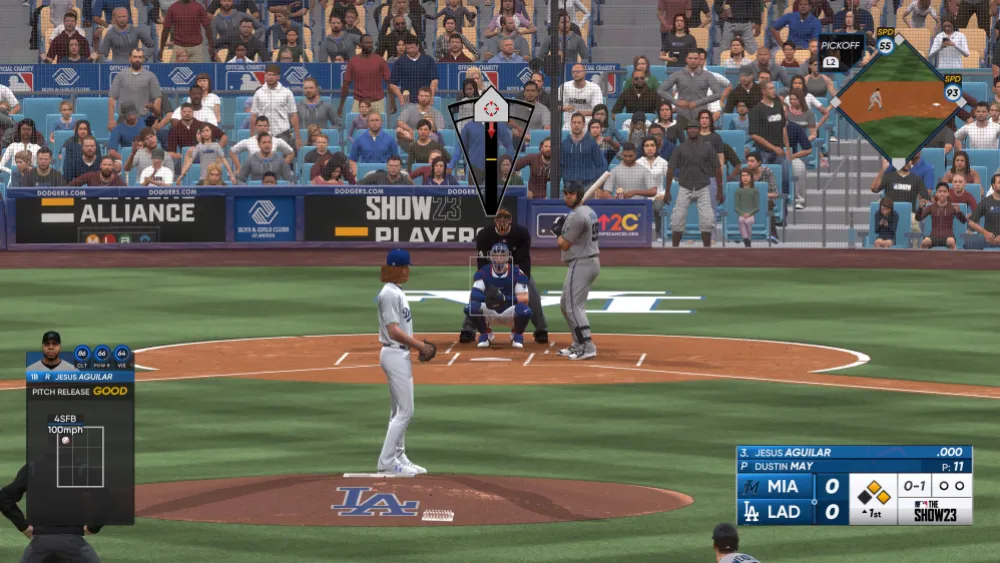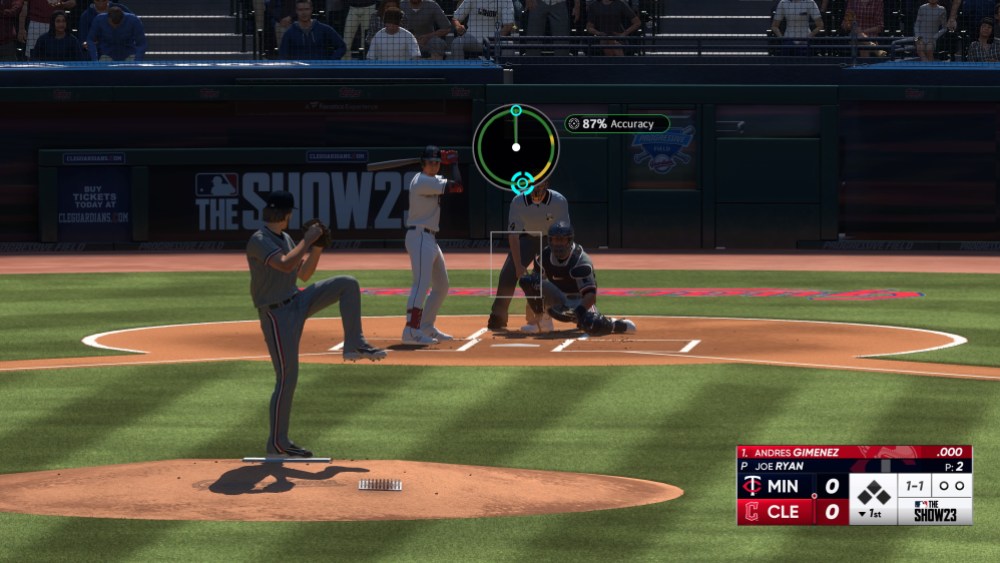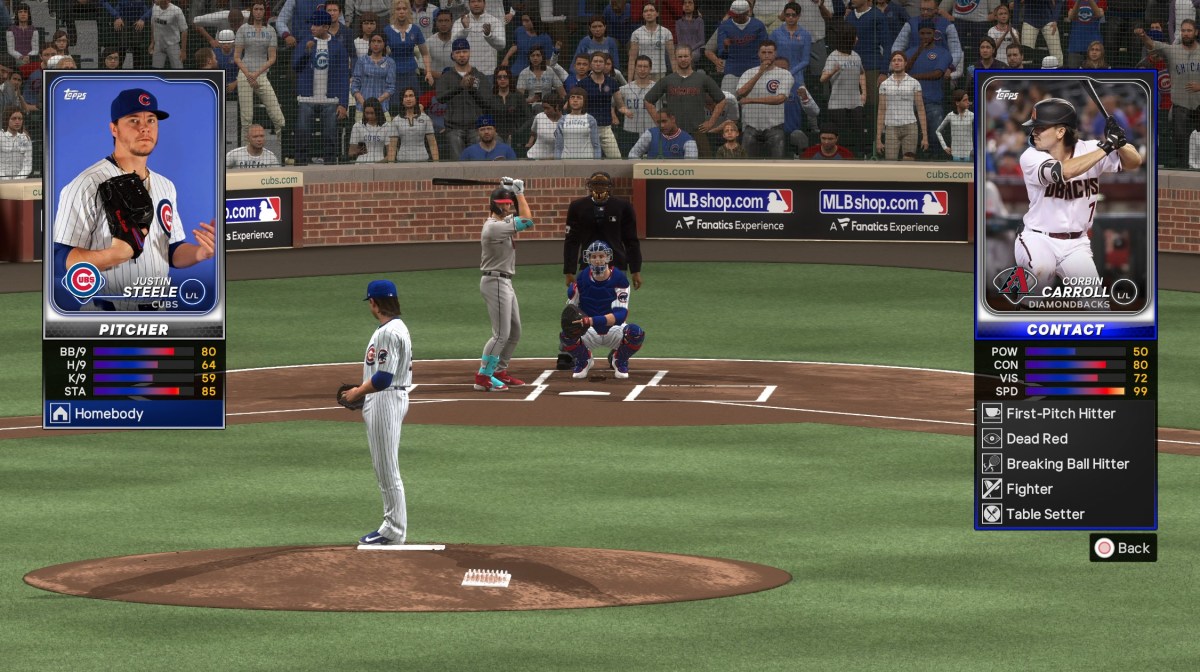Much like the last couple years, MLB The Show 24 does not have any new pitching interfaces. However, this year, the SDS developers did incorporate new gestures for one interface and some new gestures as well for that same interface, so the “degree of difficulty” has changed this year.
With that in mind, we’re mostly translating our article on this topic from ’23 over to this year, but we’re updating the Pinpoint section, which is also the most popular pitching style among the online community (and the default pitching method).

Classic
Degree of Difficulty: 1
What Is It? The classic interface has you select a pitch, aim where you want it to go, and then deliver it to the plate with the push of a button. You can hold down the button longer for more velocity/break while sacrificing accuracy or tap it instead to prioritize accuracy. Whether or not it hits your target though is determined almost entirely by the attributes of your pitcher (and maybe a little RNG).
Pros: It’s obviously very easy to perform, what with only needing a single push of a button and all to deliver each pitch. This interface also ensures the most realistic outcomes in terms of control on every pitch because attributes are the only factor. That means you can expect to concede a healthy number of walks, especially with pitchers who habitually can’t find the strike zone in real life.
Cons: In short, it could be boring. It can feel more like you’re watching a game rather than being involved in it when you’re on the mound and pushing a button over and over. It’s the worst possible option in online play because of how little influence you’ll have in hitting the corners consistently.
Best Mode: Franchise mode, for die-hard stat nerds who want their pitchers to have the most true-to-life stats possible.
Pulse
Degree of Difficulty: 3
What Is It? A timing-based method where the goal is to hit the button when the rapidly shrinking circle is at its smallest if you want your pitch to be as accurate as possible.
Pros: It shouldn’t take too long to get accustomed to using the interface and have you able to consistently nail the precise timing required. The one click involved to deliver a pitch is only a third (check my math) of the number of clicks involved compared to using meter.
Cons: The common complaint about pulse is that, even if you’re adept with the interface, pitches can still tend to not go exactly where you want. If you’re not receiving “good” feedback from the interface, you can expect to cruise a lot of pitches over the heart of the plate for what should amount to batting practice for hitters.
Best Mode: Diamond Dynasty offline only, if it’s your preferred interface.
Meter

Degree of Difficulty: 4
What Is It? The OG pitching interface of MLB The Show, it’s a 3-click method that starts with having you input power and then tasks you with nailing the timing if you hope to be accurate with your arsenal of pitches. This was the default method to pitch before analog, pulse, and pinpoint pitching.
Pros: There’s a reason that it’s been around for so long now and that’s how well its rhythm approach can mimic a pitcher finding a groove on the mound. The way the accuracy window increases when a pitcher is really dealing is a nice representation of a pitcher getting into the zone.
Cons: For anyone who has played the MLB The Show series since its early days, they’re bound to be at least a little tired of using the interface at this point. It can be deceptively challenging as well to continuously hit your desired mark with that final click, particularly when to shrinks down to just a sliver for a struggling pitcher.
Best Mode: Franchise mode, for those who want a decent level of realism but also would like to retain at least some amount of input into where their pitches end up.
Analog

Degree of Difficulty: 5
What Is it? As you’d expect with its name, the interface involves moving the analog stick back to begin your pitch and then forward at both the right moment and angle to hit your desired location. This used to be the default method before “pinpoint” became the new thing.
Pros: Combining timing with stick skills, the risk/reward when using analog is fairly decent and should lead to good command if you don’t mess anything up within the interface. It’s less involved than pinpoint pitching because you don’t need to worry about tracing various shapes for different pitches like you do with pinpoint.
Cons: Because you’re not needing to do as much on the sticks as you do with pinpoint, the results, as you might expect, are pitches that are just slightly less accurate based on your input. There’s a good argument to be made for jumping in and learning how to use pinpoint pitching if you prefer the analog stick, especially if you’re going to be playing online at all.
Best Mode: Diamond Dynasty offline if it’s your preferred interface but only take it online if you’re really good at it.
Pinpoint

Degree of Difficulty: 9
What Is It? Pinpoint pitching has you maneuvering the analog stick in different ways for each type of pitch, influencing a pitch’s ultimate location based on both the timing and how precise you are with that analog stick. New this year is the motions have been flipped based on whether your pitcher is a LHP or RHP. This means you’ll need to get comfortable doing the motions all over again with LHP even if you always used this method. On top of that, sinkers got a new gesture, and it makes throwing them much harder than in prior years.
Pros: Pinpoint likely gives you the best chance at putting a pitch where you want it, provided you’re able to regularly produce perfect feedback from your movements. It’s also incredibly involving, constantly keeping you on your toes with replicating the required intricate stick maneuvers of those like the dreaded circle changeup. This is even more true with ’24.
Cons: It can take a while to get the hang of pinpoint pitching, and until you’re familiar with what’s required from the interface it can be frustrating when you continuously hang meatballs over the plate or lead a parade of walked batters. On top of that, the amount of gestures you have to learn has effectively been doubled this year since you need to know how to mirror the motions with LHP and RHP now.








Published: Mar 20, 2024 8:49 PM UTC